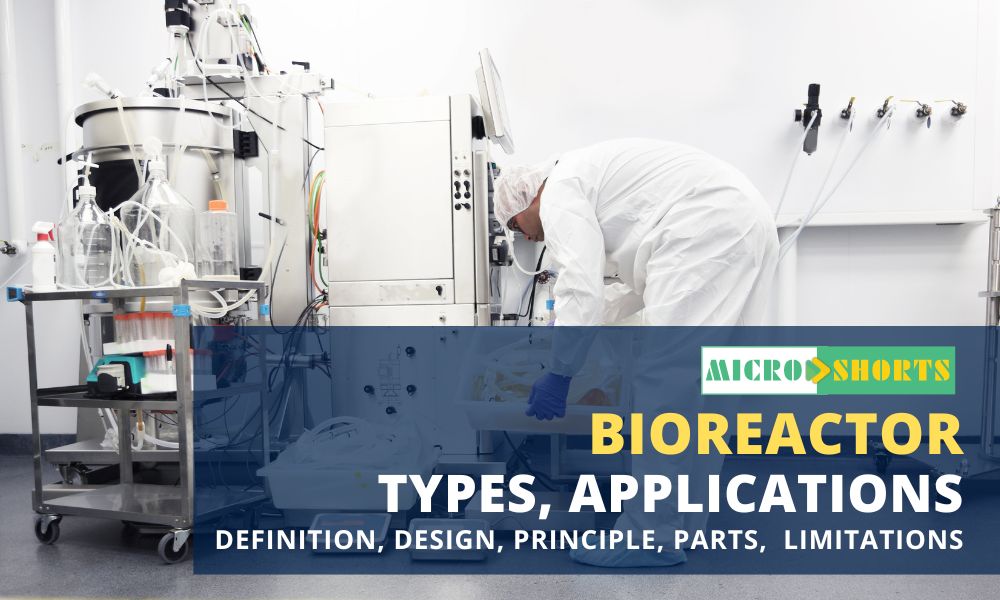Bioreactor
A bioreactor
is a type of fermentation vessel
that is used for the production of various chemicals and biological
reactions. It is a closed container with adequate arrangement for
aeration, agitation, temperature and pH control, and drain or overflow vent to
remove the waste biomass of cultured microorganisms along with their products.
A bioreactor
should provide for the following:
- Agitation (for mixing of cells and medium),
- Aeration (aerobic fermentors); for O2 supply,
- Regulation of factors like temperature, pH,
pressure, aeration, nutrient feeding, and liquid leveled.
- Sterilization and maintenance of sterility,
and
- Withdrawal of cells/medium
Bioreactors
are used for the production of biomass, metabolites, and antibiotics.
Bioreactor.
Created with BioRender.com.
Bioreactor Design
- The design and mode of operation of a bioreactor
are based on the production of an organism, optimum conditions required
for desired product formation, product value, and its scale of production.
- A good bioreactor design will help to improve
productivity and provide higher quality products at lower prices.
- A bioreactor is a device that consists of various
features such as an agitator system, an oxygen delivery system, a foam
control system, and a variety of other systems such as temperature &
pH control system, sampling ports, cleaning, and sterilization system, and
lines for charging & emptying the reactor.
- The material used for the construction of a
bioreactor must have the following important properties:
- It should not be corrosive.
- It should not add any toxic substances to the
fermentation media.
- It should tolerate the steam sterilization
process.
- It should be able to tolerate high pressure and
resist pH changes.
- The sizes of the bioreactor vary widely depending
on the application.
- Some bioreactors are designed for small scale
fermenters and some for large scale industrial applications from the
microbial cell (few mm3) to shake flask (100-1000 ml) to the
laboratory-scale fermenter (1 – 50 L) to pilot level (0.3 – 10 m3) to
plant scale (2 – 500 m3) for large volume).
Bioreactor Principle
- The bioreactor is the heart of any biochemical
process as it provides an environment for microorganisms to obtain optimal
growth and produce metabolites for the biotransformation and bioconversion
of substrates into desirable products.
- The reactors can be engineered or manufactured
based on the growth requirements of the organisms used.
- Reactors are machines that can be made to transform
biological-based materials into desirable products.
- They can be used for the production of various
enzymes and other bio-catalysis processes.
Parts of the bioreactor and their function
- These reactors have been designed to maintain
certain parameters like flow rates, aeration, temperature, pH, foam
control, and agitation rate.
- The number of parameters that can be monitored and
controlled is limited by the number of sensors and control elements
incorporated into a given bioreactor
- Other factors should be kept in mind before designing a fermenter as described below and demonstrated in the figure below.

1. Fermenter Vessel
- A fermenter is a large cylinder closed at the top
and bottom connected with various pipes and valves.
- The vessel is designed in such a way that
it allows to work under controlled conditions.
- Glass and stainless steels are two types of
fermenter vessels used.
- The glass vessel is usually used in small-scale
industries. It is non-toxic and corrosion-proof.
- Stainless steel vessel is used in large scale industries. It can resist pressure and corrosion.
2. Heating and Cooling Apparatus
- The fermentor vessel’s exterior is fitted with a
cooling jacket that seals the vessel and provides cooling water.
- Thermostatically controlled baths or internal coils
are generally used to provide heat while silicone jackets are used to
remove excess heat.
- A cooling jacket is necessary for sterilization of
the nutrient medium and removal of the heat generated during fermentation
in the fermentor.
3. Aeration System
- An aeration system is one of the very important
parts of a fermentor.
- It is important to choose a good aeration system to
ensure proper aeration and oxygen availability throughout the culture.
- It contains two separate aeration devices (sparger
and impeller) to ensure proper aeration in a fermentor.
- The stirring accomplishes two things:
- It helps to mix the gas bubbles through the liquid
culture medium and
- It helps to mix the microbial cells through the
liquid culture medium which ensures the uniform access of microbial cells
to the nutrients.
4. Sealing Assembly
- The sealing assembly is used for the sealing of the
stirrer shaft to offer proper agitation.
- There are three types of sealing assembly in the
fermenter:
- Packed gland seal
- Mechanical seal
- Magnetic drives
5. Baffles
- The baffles are incorporated into fermenters to
prevent a vortex improve aeration in the fermenters.
- It consists of metal strips attached radially to
the wall.
6. Impeller
- Impellers are used to provide uniform suspension of
microbial cells in different nutrient mediums.
- They are made up of impeller blades attached to a
motor on the lid.
- Impeller blades play an important role in reducing
the size of air bubbles and distribute them uniformly into the
fermentation media.
- Variable impellers are used in the fermenters and
are classified as follows.
- Disc turbines
- Variable pitch open turbine
7. Sparger
- A sparger is a system used for introducing sterile
air to a fermentation vessel. It helps in providing proper aeration to the
vessel.
- The sparger pipes contain small holes of about 5-10
mm, through which pressurized air is released.
- Three types of sparger are used
- Porous sparger
- Nozzle sparger
- Combined sparger–agitator
8. Feed Ports
- They are used to add nutrients and acid/alkali to
the fermentor.
- Feed ports are tubes made up of silicone.
- In-situ sterilization is performed before the
removal or addition of the products.
9. Foam-Control
- The level of foam in the vessel must be minimized
to avoid contamination, this is an important aspect of the fermentor.
- Foam is controlled by two units, foam sensing, and
a control unit.
- A foam-controlling device is mounted on top of the
fermentor, with an inlet into the fermentor.
10. Valves
- Valves are used in the fermentor to control the
movement of liquid in the vessel.
- There are around five types of valves are used,
that is,
- globe valve,
- butterfly valve,
- a ball valve, and
- diaphragm valve.
- A safety valve is built-in in the air and pipe
layout to operate under pressure
11. Controlling Devices for Environmental Factors
- A variety of devices are utilized to control
environmental elements like temperature, oxygen concentration, pH, cell
mass, essential nutrient levels, and product concentration.
12. Use of Computer in Fermenter
- For an efficient process, monitoring, and data
collecting, fermentors are generally coupled with modern automated and
semi-automated computers and databases.
Types of bioreactor
The fermentor
(bioreactor) types used extensively in industries are
1. Continuous stirred tank fermentor
- A continuous stirred tank bioreactor is made up of
a cylindrical vessel with a central shaft controlled by a motor that
supports one or more agitators (impellers).
- The sparger, in combination with impellers
(agitators), allows for improved gas distribution throughout the vessel.
- A stirred tank bioreactor can
be operated continuously in the fermentor, temperature
control is effortless, construction is
cheap, easy to operate, resulting in low labor
cost, and it is easy to clean.
- It is the most common type of bioreactor used in
industry.

2. Airlift fermentor
- The airlift reactor is generally used for
gas-liquid or gas-liquid-solid contact devices. It is also known as a
tower reactor.
- A bioreactor using an airlift system divides the
fluid volume into two zones to improve circulation, oxygen transfer, and
equalize forces in the reactor
- In a two-zone system, only one zone is sparged with
gas. The zone where the gas is sparged is the riser; the zone in which it
is not sparged in the downcomer.
- Airlift bioreactors are used for aerobic
bioprocessing technology so that they can provide a controlled liquid flow
in a recycling system using pumps.
- This equipment has several advantages such as its simplicity of design because it doesn’t contain any moving parts or agitators, its easy sterilization, its low energy requirements, and its low cost.

3. Bubble
column fermentor
- The bubble column fermentor consists of a
cylindrical vessel equipped with a gas sparger that pushes gas bubbles
into a liquid phase or a liquid-solid suspension.
- The base of the column air or gas is introduced via
perforated pipes or plates, or metal micro porous sparger.
- The rheological properties of the fluid and the gas
flow rate have a significant influence on the mixing of O2 and other
performance factors.
- To improve mass transfer and modify the basic
design of the vessel, internal devices such as horizontal perforated
plates, vertical baffles, and corrugated sheet packings placed are in the
vessel.
- These reactors are simple in construction, easy
maintenance, and have a low operating cost
- Bubble columns reactors are used in biochemical processes such as fermentation and biological wastewater treatment. It is also used in many chemical, petrochemical, and biochemical industries.

4.
Fluidized-bed fermentor
- Fluid bed bioreactors constitute packed beds with
smaller particles. This prevents problems such as clogging, high liquid
pressure drop, channeling, and bed compaction associated with packed bed
reactors.
- Catalyst is laid on the bottom of the reactor and the
reactants are pumped into the reactor through a distributor pump to make
the bed fluidized.
- In these reactors, the cells are immobilized small
particles which move with the fluid as a result, mass transfer, oxygen
transfer, and nutrition to the cells are enhanced.
- The bioreactors can be used for reactions involving
fluid-suspended biocatalysts, such as immobilized enzymes, immobilized
cells, and microbial flocs.
- Its main advantages include its ability to maintain even temperatures, easy replacement and regeneration of the catalyst, continuity, and automaticity of operation, and reduced contact time between gas and solid, compared to other catalytic reactors.

5. Packed
bed fermentor
- A packed bed fermentor is a bed of solid particles,
having biocatalyst on or within, the matrix of solids.
- It can either be run in the submerged mode (with or
without aeration) or the trickle flow mode.
- Frequently used in chemical processing processes
such as absorption, distillation, stripping, separation process, and
catalytic reactions, packed bed reactors are also called fixed bed
reactors.
- In packed-bed bioreactors, the air is introduced
through a sieve that supports the substrate.
- This reactor has many benefits, like a high conversion rate for the catalyst, ease of operation, low construction and operation costs, increased contact between reactant and catalyst, and the ability to work in high temperatures and pressures.

6.
Photobioreactor
- A photobioreactor is a specialized unit for
fermentation that is either illuminated by direct sunlight or artificially
illuminated
- They are made up of glass or more commonly
transparent plastic and the tubes or flat panels is consist of light
receiving systems.
- In this bioreactor, centrifugal pumps or airlift
pumps can be used to circulate the medium through solar receivers.
- Photo-bioreactors are usually operated in a
continuous mode at a temperature in the range of 25–40 °C.
- Photobioreactors are used for the photosynthetic
culture of microalgae and cyanobacteria to produce products such as
astaxanthin and β-carotene.

7. Membrane bioreactor
- This system combines traditional treatment with
membrane filtration, resulting in the removal of organics and suspended
solids as well as the removal of high nutrient levels.
- Membranes in this system are submerged in an
aerated biological reactor. The pore size of the membrane ranges from
0.035 microns to 0.4 microns.
- With pure oxygen, the benefits of this bioreactor are enhanced resulting in even higher rate biological treatment systems that provide compact control of COD, microorganisms.

Applications
of bioreactor
Some
important applications of the bioreactor are:
|
Type of
bioreactor |
Applications |
|
Stirred
tank fermenter |
Antibiotics,
citric acid, Exopolysaccharides, cellulose, Chitinolytic enzymes, Laccase,
Xylanase, Pectic, and pectate lyase, Tissue mass culture, Lipase,
Polygalacturonases, Succinic acid |
|
Bubble
column fermentor |
Algal
culture, Chitinolytic enzymes |
|
Airlift
fermentor |
Antibiotics,
Chitinolytic enzymes, Exopolysaccharides, Gibberelic acid, Laccase,
Cellulase, Lactic acid, Polygalacturonases, Tissue mass culture |
|
Fluid bed
fermentor |
Laccase |
|
Packed bed
fermentor |
Laccase,
Hydrogen, Organic acids, Mammalian cells, |
|
Photobioreactor |
Wastewater
treatment, water quality management, remediation of contaminated soil |
|
Membrane
bioreactor |
Alginate,
Antibiotic, Cellulose hydrolysis, Hydrogen production, Water treatment, VOCs
treatment |
Limitations of bioreactor
|
Types of
bioreactor |
Limitation |
|
Stirred
tank fermenter |
High shear
stress |
|
High power
consumption |
|
|
Moving
internal parts |
|
|
Bubble
column bioreactor |
Low
photosynthetic efficiency |
|
Airlift |
Non-uniform
nutrient supply |
|
Insufficient
mixing |
|
|
High
viscosity can limit bulk circulation |
|
|
Fluid bed
fermentor |
Particle
(breakup) is common |
|
Increased
reactor vessel size |
|
|
Bubbling
beds of fine particles are difficult to predict and are less efficient. |
|
|
Pipe and
vessel walls erode due to collisions by particles |
|
|
Packed bed
bioreactor |
Undesired
heat gradients |
|
Poor
temperature control |
|
|
Difficult
to replace the catalyst |
|
|
Photobioreactor |
Salability
problems |
|
Require
temperature maintenance as they lack evaporative cooling |
|
|
Periodic
cleaning due to light exposure |
|
|
Need
maximum light exposure |
|
|
Membrane
bioreactor |
Biofilm
overgrowth leads to periodic cleaning |
|
The
membrane can rupture at high flow rates |









Comments